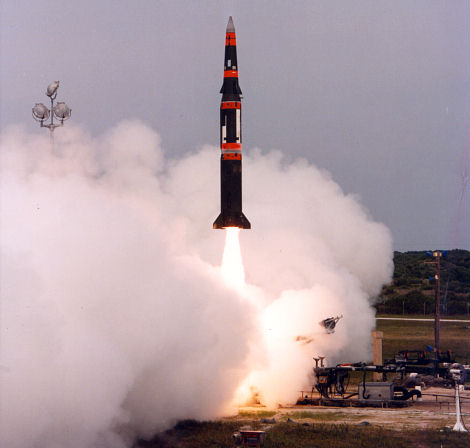PERSHING II FACT SHEET
By Cliff Lethbridge

Pershing II Launch, Photo Courtesy U.S. Army
Classification: Intermediate-Range Ballistic Missile
Length: 34 feet, 10 inches
Diameter: 3 feet, 4 inches
Finspan: 6 feet, 9 inches
Range: 1,100 miles
Date of First Cape Canaveral Launch: July 22, 1982
Date of Final Cape Canaveral Launch: March 21, 1988
Number of Cape Canaveral Launches: 49
By the 1970’s, the U.S. Army and contractor Martin Marietta were prepared to develop an improved version of the Pershing IA called the Pershing II. Based upon the original Pershing missiles, the Pershing II contained technological and operational improvements which resulted in greater range and accuracy. Accuracy was dramatically improved with the addition of a Goodyear radar area correlation guidance system. The device compared oncoming targets with images recorded in computer memory. Since the Pershing II was more accurate than the Pershing I and Pershing IA, it was considered capable of causing at least as much damage to a specific target while carrying a smaller weapons payload. For this reason, the nuclear warhead capability of the Pershing II was reduced to 50 kilotons compared to 400 kilotons for the Pershing I and Pershing IA. In addition, the Pershing II was equipped with an advanced, deadly ground-penetrating warhead which could cause considerable damage even to reinforced or underground structures.
Production of the Pershing II was stepped up in the mid to late 1970’s in response to an increasing Soviet deployment of intermediate to long-range mobile land-based missiles. The first Pershing II test launch occurred on July 22, 1982 from Cape Canaveral Launch Complex 16. A total of 108 Pershing II missiles were subsequently deployed in West Germany from May, 1983 through December, 1985. Test launches for troop training at Cape Canaveral continued as well. A total of six Pershing II missiles were launched from Launch Complex 16 in just one day, setting the record for land-based same-day launches from the Cape. Although the Pershing II represented the first operational IRBM for the U.S. Army since being stripped of the Jupiter missile by the “Wilson Memorandum” in 1956, this capability was to be short-lived. In 1987, U.S. President Ronald Reagan and Soviet Premier Mikhail Gorbacev signed the Intermediate Nuclear Forces (INF) Treaty. The treaty banned all land-based intermediate-range missiles, including the Pershing II. Pershing II missiles would be dismantled and destroyed. Those rendered inert and kept on display, including one at the Air Force Space and Missile Museum at Cape Canaveral, would remain open to random Soviet inspection. The U.S. Army had again lost its IRBM capability, but by treaty rather than memorandum.


